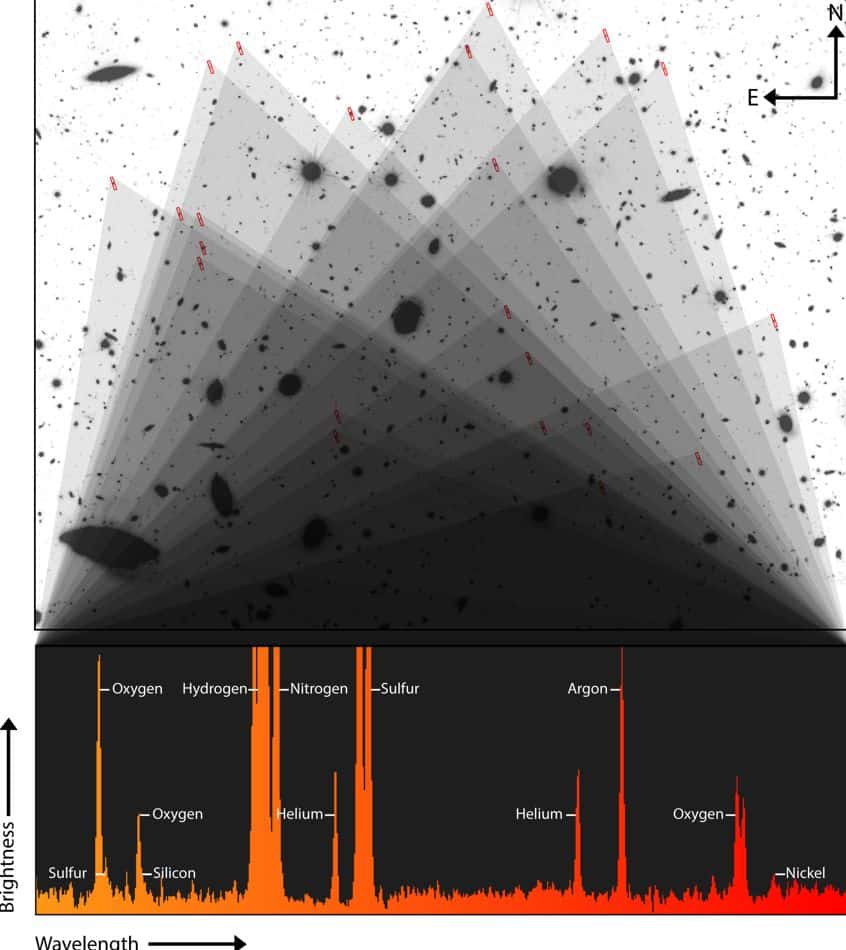“Even in nearby galaxies, people don’t observe this.”
Like their human counterparts, galaxies in their teenage phase are complex, undergoing rapid growth, and have a penchant for the heavier side of the periodic table—specifically nickel.
A team of astrophysicists from Northwestern University has analyzed initial findings from the CECILIA (Chemical Evolution Constrained using Ionized Lines in Interstellar Aurorae) Survey, leveraging NASA’s James Webb Space Telescope (JWST) to probe the chemical composition of remote galaxies.
The preliminary data reveal that these ‘teenage galaxies,’ which emerged around two to three billion years post-Big Bang, are exceptionally warm and brimming with elements like nickel.
The findings were published today in The Astrophysical Journal Letters.
Northwestern’s Allison Strom, lead author of this study, explains, “We’re trying to understand how galaxies grew and changed over the 14 billion years of cosmic history.”
The JWST enables researchers to study these young galaxies during their turbulent phase of development, analogous to human adolescence, which often sets the stage for their future.
Allison Strom, a lead figure in the CECILIA Survey and an assistant professor of physics and astronomy at Northwestern’s Weinberg College of Arts and Sciences, collaborates with Gwen Rudie, a staff scientist at Carnegie Observatories.
Understanding Galaxy Formation Through ‘Chemical DNA’
The CECILIA Survey, named in honor of Cecilia Payne-Gaposchkin, a pioneering woman in astronomy, analyzes the light spectrum from distant galaxies, considered their ‘chemical DNA.’ This approach helps understand the growth and future evolution of these galaxies.
Researchers are still unraveling why certain galaxies cease forming stars, appearing ‘red and dead,’ while others continue to be star-forming like the Milky Way. Analyzing a galaxy’s spectrum reveals crucial elements like oxygen and sulfur, offering insights into its past actions and potential future.
“These teenage years are really important because that’s when the most growth happens,” says Strom.
The JWST’s observations of 33 distant young galaxies last summer, subsequently merging 23 of their spectra, provide a broader perspective on average galactic characteristics and fainter details, surpassing what ground-based telescopes could achieve.
“This washes out the details of individual galaxies but gives us a better sense of an average galaxy. It also allows us to see fainter features,” Strom adds. “It’s significantly deeper and more detailed than any spectrum we could collect with ground-based telescopes of galaxies from this time period in the universe’s history.”

Surprises in the Spectral Analysis
The exceptionally deep spectral analysis uncovered eight unique elements: hydrogen, helium, nitrogen, oxygen, silicon, sulfur, argon, and nickel. Since any element heavier than hydrogen and helium is synthesized within stars, their detection offers clues to the history of stellar birth during a galaxy’s development.
Strom was particularly astonished by the detection of nickel, a rare and hard-to-spot element.
“Never in my wildest dreams did I imagine we would see nickel,” Strom remark. “Even in nearby galaxies, people don’t observe this. There has to be enough of an element present in a galaxy and the right conditions to observe it. No one ever talks about observing nickel. Elements have to be glowing in gas in order for us to see them. So, in order for us to see nickel, there may be something unique about the stars within the galaxies.”
An additional unexpected finding was the intense heat of the teenage galaxies. Through spectral analysis, physicists have the means to measure a galaxy’s temperature. While the warmest regions within galaxies might hit temperatures above 9,700 degrees Celsius (17,492 degrees Fahrenheit), these younger galaxies were found to be even hotter, exceeding temperatures of 13,350 degrees Celsius (24,062 degrees Fahrenheit).
“This is just additional evidence of how different galaxies likely were when they were younger,” Strom adds. “Ultimately, the fact that we see a higher characteristic temperature is just another manifestation of their different chemical DNA because the temperature and chemistry of gas in galaxies are intrinsically linked.”
This research, titled “CECILIA: Faint emission line spectrum of z~2-3 star-forming galaxies,” is supported by various institutions including NASA. The data were sourced from the Mikulski Archive for Space Telescopes at the Space Telescope Science Institute and the W.M. Keck Observatory.
Image Credit: iStock – The James Webb Space Telescope (JWST) was sighted in the southern sky from the University of Hyderabad campus in Hyderabad, India, on December 25, 2021, at 6:30 PM IST, shortly after its solar array was fully deployed. The observation took place between 6:30 PM and 6:45 PM IST on the same day. NASA’s JWST launch occurred earlier that day at 5:50 PM IST, and approximately 40 minutes post-launch, the telescope made its passage over India.
